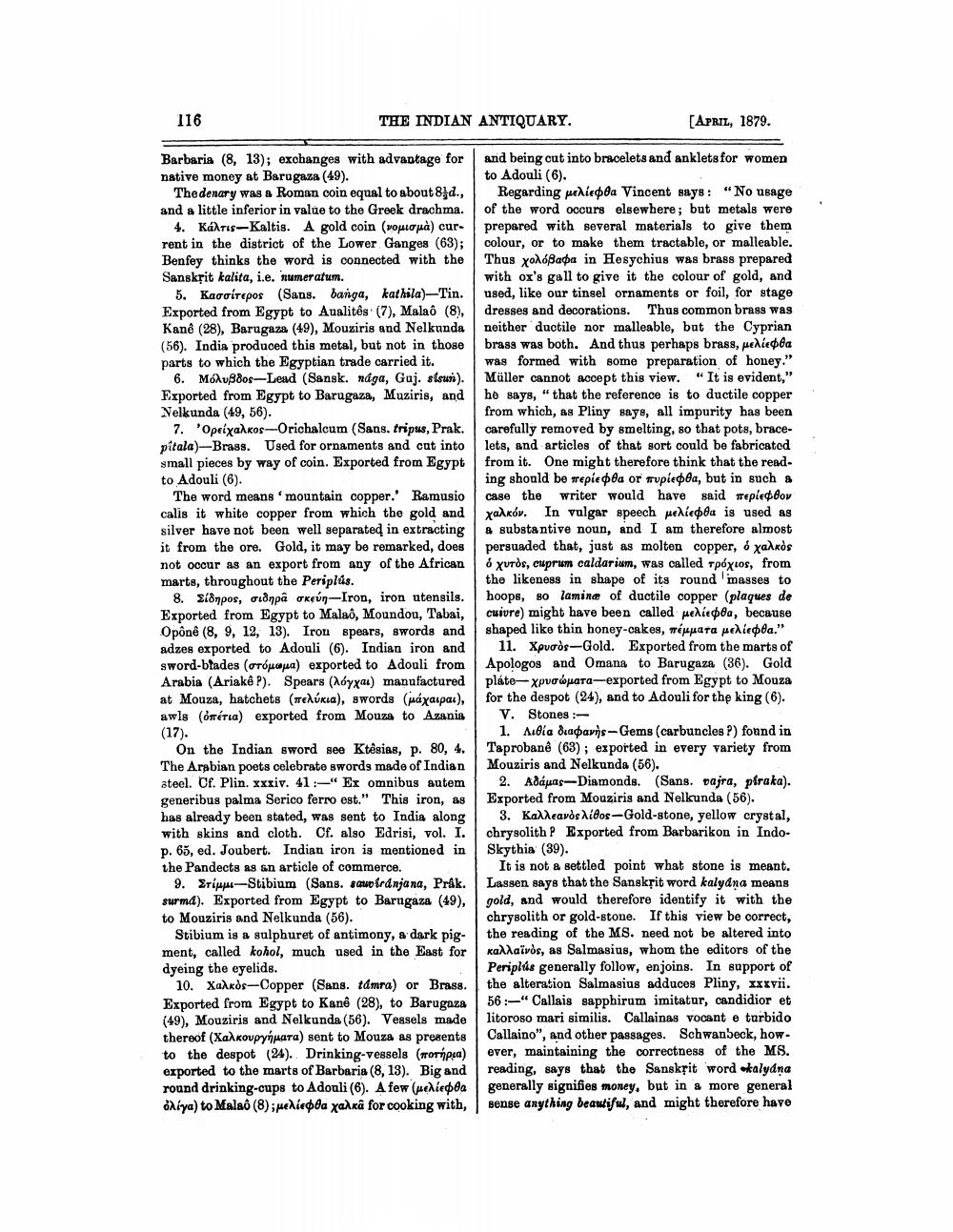________________
116
THE INDIAN ANTIQUARY.
[APRIL, 1879.
Barbaria (8, 13); exchanges with advantage for native money at Barugaza (49).
The denary was a Roman coin equal to about 8 d., and a little inferior in value to the Greek drachma
4. Káris-Kaltis. A gold coin (voulouà) current in the district of the Lower Ganges (63); Benfey thinks the word is connected with the Sansksit kalita, i.e. numeratum.
5. Kacoirepos (Sans. banga, kathila)-Tin. Exported from Egypt to Aualitês (7), Malaô (8), Kanê (28), Barugaza (49), Mouziris and Nelkunda (56). India produced this metal, but not in those parts to which the Egyptian trade carried it.
6. MóAußdos-Lead (Sansk. nága, Gaj. sisuri). Exported from Egypt to Barugaza, Muziris, and Nelkunda (49, 56).
7. 'Opeixalkos---Orichalcum (Sans. trips, Prak. pitala)-Brass. Used for ornaments and cut into small pieces by way of coin. Exported from Egypt to Adouli (6).
The word means 'mountain copper.' Ramusio calis it white copper from which the gold and silver have not been well separated in extracting it from the ore. Gold, it may be remarked, does not occur as an export from any of the African marts, throughout the Periplus.
8. Stenpos, orionpa keun-Iron, iron utensils. Exported from Egypt to Malaô, Moundou, Tabai, Opône (8, 9, 12, 13). Iron spears, swords and adzes exported to Adouli (6). Indian iron and sword-btades (orówpa) exported to Adouli from Arabia (Ariakê P). Spears (byxau) manufactured at Mouza, hatchets (TENúria), swords (máxaipat), awls (oméria) exported from Mouza to Azania (17).
On the Indian sword see Ktêsias, p. 80, 4. The Arabian poets celebrate swords made of Indian ateel. Cf. Plin. xxxiv. 41:-"Ex omnibus autem generibus palma Serico ferro est." This iron, as has already been stated. was sent to India along with skins and cloth. Cf. also Edrisi, vol. I. p. 65, ed. Joubert. Indian iron is mentioned in the Pandects as an article of commerce.
9. Srium-Stibium (Sans. satidiranjana, Prák. surmd). Exported from Egypt to Barugaza (49), to Mouziris and Nelkunda (56).
Stibium is a sulphuret of antimony, a dark pigment, called kohol, much used in the East for dyeing the eyelids.
10. Xalds-Copper (Sans. tdmra) or Brass. Exported from Egypt to Kanê (28), to Barugaza (49), Mouziris and Nelkunda (56). Vessels made thereof (Xalkoupyhuara) sent to Mouza as presents to the despot (24). Drinking-vessels (Forupa) exported to the marts of Barbaria (8, 13). Big and round drinking-cups to Adouli (6). A few (uchiepla öniya) to Malað (8); Mehiepa xarxa for cooking with,
and being cut into bracelets and anklets for women to Adouli (6).
Regarding uchiepda Vincent says: "No usage of the word occurs elsewhere; but metals were prepared with several materials to give them colour, or to make them tractable, or malleable. Thus xolópapa in Hesychius was brass prepared with ox's gall to give it the colour of gold, and used, like our tinsel ornaments or foil, for stage dresses and decorations. Thus common brass was neither ductile nor malleable, but the Cyprian brass was both. And thus perhaps brass, pelepa was formed with some preparation of honey." Müller cannot accept this view. "It is evident," he says, "that the reference is to ductile copper from which, as Pliny saye, all impurity has been carefully removed by smelting, so that pots, bracelets, and articles of that sort could be fabricated from it. One might therefore think that the reading should be περίεφθα ο πυρίεφθα, but in such και case the writer would have said tepledov xalkov. In vulgar speech ueliepa is used as
substantive noun, and I am therefore almost persuaded that, just as molten copper, 6 xalos
xurds, cuprum caldarium, was called Tpóxtos, from the likeness in shape of its round 'masses to hoops, so laminæ of ductile copper (plaques de cuivre) might have been called Mediepa, because shaped like thin honey-cakes, émata uchlega."
11. Xpuoros-Gold. Exported from the marts of Apologos and Omana to Barugaza (36). Gold pláte-xpuobuara-exported from Egypt to Mouza for the despot (24), and to Adouli for the king (6).
V. Stones :
1. Aldía dapavis-Gems (carbuncles ) found in Taprobanê (63); exported in every variety from Mouziris and Nelkunda (56).
2. Adáuas-Diamonds. (Sans. vajra, piraka). Exported from Mouziris and Nelkunda (56).
3. Kallcards aidos-Gold-stone, yellow crystal, chrysolith P Exported from Barbarikon in IndoSkythis (39).
It is not a settled point what stone is meant. Lassen says that the Sansksit word kalyana means gold, and would therefore identify it with the chrysolith or gold-stone. If this view be correct, the reading of the MS. need not be altered into kallaivos, as Salmasius, whom the editors of the Periplús generally follow, enjoins. In support of the alteration Salmasius adduces Pliny, xxxvii. 56 :-“Callais sapphirum imitatur, candidior et litoroso mari similis. Callainas vocant e turbido Callaino", and other passages. Schwanbeck, how ever, maintaining the correctness of the MS. reading, says that the Sanskrit word kalydna generally signifies money, but in a more general sense anything beautiful, and might therefore have




